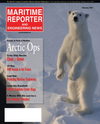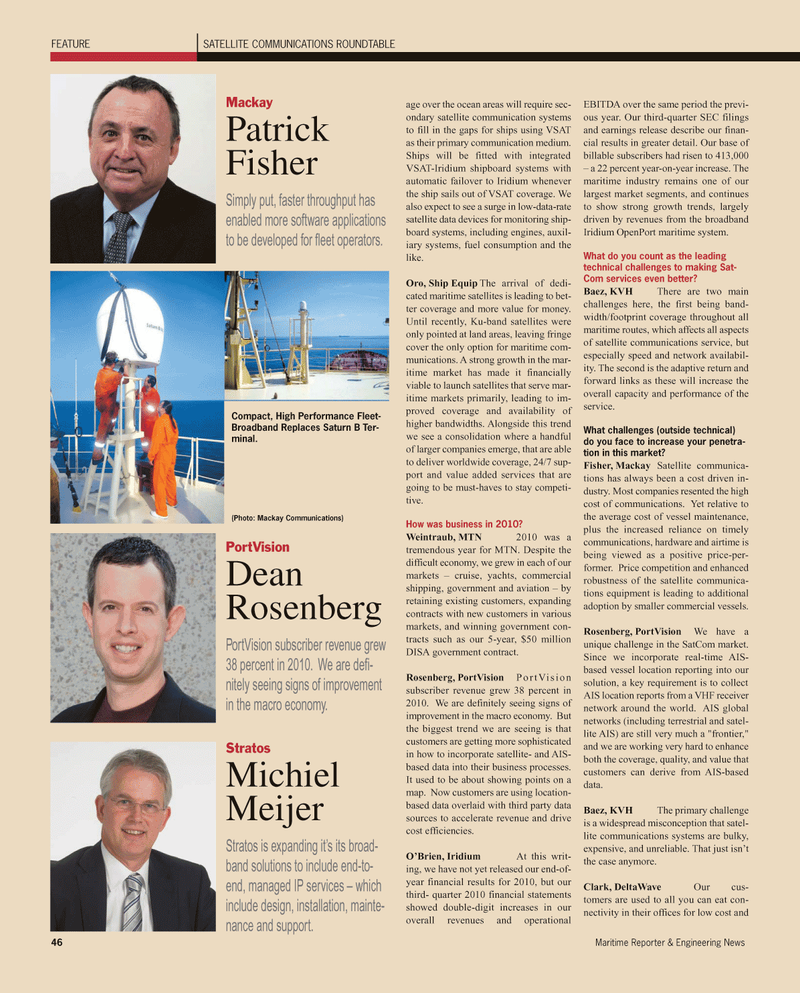
Page 46: of Maritime Reporter Magazine (February 2011)
Cruise & Passenger Vessel Annual
Read this page in Pdf, Flash or Html5 edition of February 2011 Maritime Reporter Magazine
46 Maritime Reporter & Engineering News
FEATURE SATELLITE COMMUNICATIONS ROUNDTABLE
Stratos
Michiel
Meijer
Stratos is expanding it’s its broad- band solutions to include end-to- end, managed IP services – which include design, installation, mainte- nance and support.
PortVision
Dean
Rosenberg
PortVision subscriber revenue grew 38 percent in 2010. We are defi- nitely seeing signs of improvement in the macro economy.
Mackay
Patrick
Fisher
Simply put, faster throughput has enabled more software applications to be developed for fleet operators.
Compact, High Performance Fleet-
Broadband Replaces Saturn B Ter- minal. (Photo: Mackay Communications) age over the ocean areas will require sec- ondary satellite communication systems to fill in the gaps for ships using VSAT as their primary communication medium.
Ships will be fitted with integrated
VSAT-Iridium shipboard systems with automatic failover to Iridium whenever the ship sails out of VSAT coverage. We also expect to see a surge in low-data-rate satellite data devices for monitoring ship- board systems, including engines, auxil- iary systems, fuel consumption and the like.
Oro, Ship Equip The arrival of dedi- cated maritime satellites is leading to bet- ter coverage and more value for money.
Until recently, Ku-band satellites were only pointed at land areas, leaving fringe cover the only option for maritime com- munications. A strong growth in the mar- itime market has made it financially viable to launch satellites that serve mar- itime markets primarily, leading to im- proved coverage and availability of higher bandwidths. Alongside this trend we see a consolidation where a handful of larger companies emerge, that are able to deliver worldwide coverage, 24/7 sup- port and value added services that are going to be must-haves to stay competi- tive.
How was business in 2010?
Weintraub, MTN 2010 was a tremendous year for MTN. Despite the difficult economy, we grew in each of our markets – cruise, yachts, commercial shipping, government and aviation – by retaining existing customers, expanding contracts with new customers in various markets, and winning government con- tracts such as our 5-year, $50 million
DISA government contract.
Rosenberg, PortVision PortVision subscriber revenue grew 38 percent in 2010. We are definitely seeing signs of improvement in the macro economy. But the biggest trend we are seeing is that customers are getting more sophisticated in how to incorporate satellite- and AIS- based data into their business processes.
It used to be about showing points on a map. Now customers are using location- based data overlaid with third party data sources to accelerate revenue and drive cost efficiencies.
O’Brien, Iridium At this writ- ing, we have not yet released our end-of- year financial results for 2010, but our third- quarter 2010 financial statements showed double-digit increases in our overall revenues and operational
EBITDA over the same period the previ- ous year. Our third-quarter SEC filings and earnings release describe our finan- cial results in greater detail. Our base of billable subscribers had risen to 413,000 – a 22 percent year-on-year increase. The maritime industry remains one of our largest market segments, and continues to show strong growth trends, largely driven by revenues from the broadband
Iridium OpenPort maritime system.
What do you count as the leading technical challenges to making Sat-
Com services even better?
Baez, KVH There are two main challenges here, the first being band- width/footprint coverage throughout all maritime routes, which affects all aspects of satellite communications service, but especially speed and network availabil- ity. The second is the adaptive return and forward links as these will increase the overall capacity and performance of the service.
What challenges (outside technical) do you face to increase your penetra- tion in this market?
Fisher, Mackay Satellite communica- tions has always been a cost driven in- dustry. Most companies resented the high cost of communications. Yet relative to the average cost of vessel maintenance, plus the increased reliance on timely communications, hardware and airtime is being viewed as a positive price-per- former. Price competition and enhanced robustness of the satellite communica- tions equipment is leading to additional adoption by smaller commercial vessels.
Rosenberg, PortVision We have a unique challenge in the SatCom market.
Since we incorporate real-time AIS- based vessel location reporting into our solution, a key requirement is to collect
AIS location reports from a VHF receiver network around the world. AIS global networks (including terrestrial and satel- lite AIS) are still very much a "frontier," and we are working very hard to enhance both the coverage, quality, and value that customers can derive from AIS-based data.
Baez, KVH The primary challenge is a widespread misconception that satel- lite communications systems are bulky, expensive, and unreliable. That just isn’t the case anymore.
Clark, DeltaWave Our cus- tomers are used to all you can eat con- nectivity in their offices for low cost and

 45
45

 47
47
